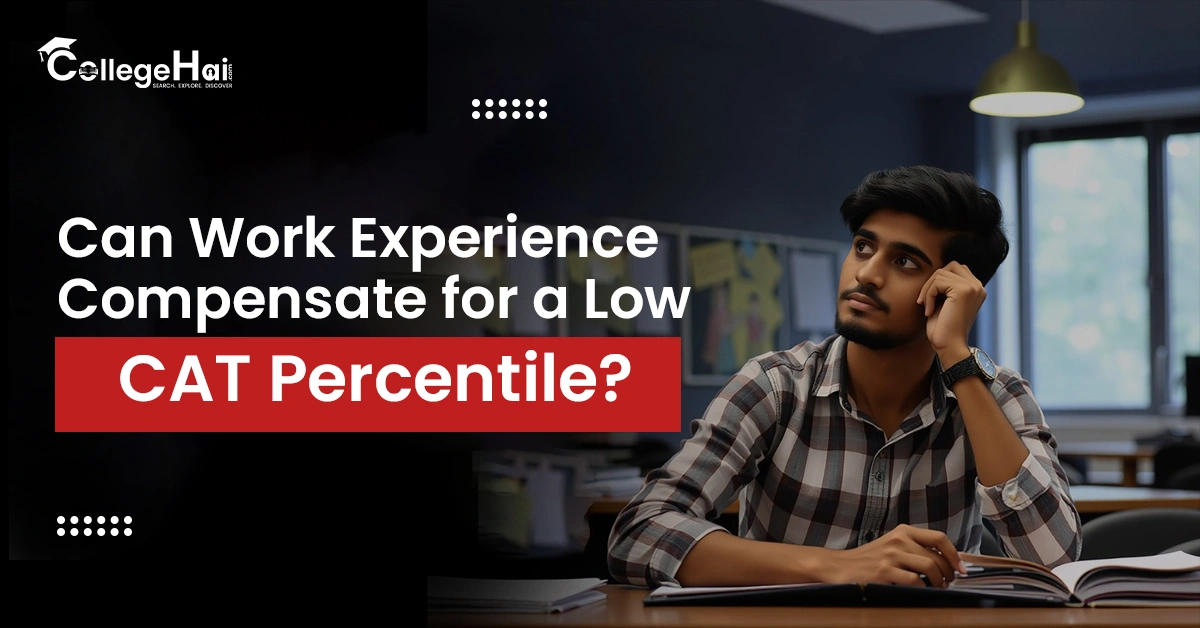Just imagine that you have spent hours and hours studying mock tests, you have sacrificed your weekends and social life, just to appear on that toughest exam of the year, the CAT exam. The scores are there with you, and your heart is sinking because your percentile is not as high as you thought. The disappointment strikes you, it whispers in your ears, and asks you questions, like, Is this the end of my IIM dreams? You are not alone in this emotional rollercoaster.
Thousands of ambitious students like you are bitten by the disappointment of failing to live up to the expectation after investing their heart and soul in preparation every year. The good news is that you have come to the right platform. This blog is not any other advice column, but it is your lifeline, full of practical advice, evidence-based solutions, and hope that is specific to strong-willed people like you.
We are here to demonstrate that a low CAT percentile does not necessarily have to be a dead end. Actually, your experience in the workplace may be the magic bullet that makes the difference. Now, it is time to get down to business and see how a professional background can fill that gap and make you pursue MBA aspirations with a newfound energy.
What are the CAT Percentiles? What is considered to be low?
Before we answer the big question, it would be important to explain what a low CAT percentile actually means when it comes to MBA admissions, particularly in the case of the best institutes such as the IIMs. The Common Admission Test (CAT) is the entrance to the highly sought-after MBA programs in India, where the scoring is in the form of a percentile, which ranks your performance among the test-takers.
In general, overall cutoffs in the best IIMs, such as Ahmedabad, Bangalore, and Calcutta, are high, typically between 99 and 100 percentiles among general category students; however, sectional cutoffs (Verbal Ability, Data Interpretation, Logical Reasoning, and Quantitative Ability) may drop as low as 70-85 percentiles. In fact, in the case of new IIMs, cutoffs may be as low as the 90th-95th percentile.
The low percentile can be a heart-breaker, like you have wasted all your efforts. The results are likely to cause anxiety, self-doubt, and even depression in the students. Nevertheless, it should not be forgotten that CAT is not the sole piece of the puzzle.
Admissions committees are holistic, and this is where work experience comes in. Provided that you have been in the labour market, developing skills and experience, it can cushion the impact of a poor score. Imagine that it is your real-life resume talking louder than one exam day.
To visualise this, look at the following pointers of the typical CAT cutoff ranges of IIM tiers:
Best IIMs (A, B, C): 99+ percentile
Old IIMs (e.g., Lucknow, Kozhikode): 95-98 percentile
Newer IIMs: 90-95 percentile
Non-IIM B-Schools with Top 50 percentiles: 85-90 percentile
At the top levels of schools, excellence is required, but there is flexibility further down the ladder, particularly when other considerations shine.
The Importance of Work Experience in MBA Admission

Now, down to the point: Is the work experience really able to make up for a low CAT percentile? The answer to this is yes, to a certain degree. Although CAT is the main filter, work experience will enrich your profile and will prove to be practical, leadership, and mature skills that freshers may not have.
Work experience in Indian MBA admissions, especially at IIMs, is weighted in the shortlisting and final selection process, and may have a qualitative influence in the interview process that is much larger than the percentage contribution. In simple words, B-schools value diversity. A group of new graduates does not have the practical insights that seasoned professionals offer to the strategy, ethics, and operations discussion.
Work experience is a buffer for low-score students in CAT. It can offset academic shortcomings or low percentiles by demonstrating strength and practicality. An example is that with a CAT of about 90-95 percentile, good work experience of about 2-5 years could get you a call from mid-tier IIMs or other high-ranking schools such as XLRI or FMS.
In case you have been undermined due to a single test, your professional success justifies your potential. A lot of students leave corporate jobs and get stuck, only to realise that their experience boosts them to MBA programs that they believed they could never afford.
The average weightage of admission in the leading IIMs is often in the range of 5-10%. This allocation indicates that work experience is not the star but a very important supporting actor.
How IIMs Evaluate Work Experience: Weightage & Impact
Going further, we will look at how certain IIMs include work experience in their criteria. Not every one of them is treated equally; some are based on points, others are graded by duration. In the case of IIM Bangalore, the work experience is rated 10 (months of experience/36) with a maximum of 10 points on pre-PI shortlisting, and 5 points on final composite. IIM Ahmedabad and Lucknow also rate work experience 5-10, with 1-3 years being preferred.
Now you must be thinking whether the mean work experience is accepted or not. At IIM Bangalore, the average experience has increased by 27 months. IIM Ahmedabad has an average experience of 1.3 years, up by 0.8 years in 2018. To low CAT scorers, quality is more important than quantity. The experience of well-known companies, managerial positions, or other industries (e.g., IT to consulting) is rated higher than the routine ones.
The following table shows the weightage of work experience (out of 100) in some IIMs:
The majority of IIMs weigh 5-10 marks to the candidates with good working experience, provided that the job was full-time and related. Thus, the CAT score is the most crucial, but your work experience will be an additional mark that will help you slightly increase your overall profile and increase your chances of being selected.
How to use your work experience to your advantage in MBA admission
Work experience can be a game-changer for students with low CAT percentiles to win a place in the best MBA programs, such as the IIMs. The following are some practical tips that you can use to capitalize on your professional experience, and they are structured in such a manner that will be attractive to ambitious students who feel the pressure of a poor score. These suggestions will help you reconnect with your emotional self in terms of your potential and pitch your experience as an asset.
1. Measure and Highlight Success
Why it is important: Admission teams like clear, measurable results more than value explanations. Numbers are a great narrative of what you have contributed.
How to do it: In your Statement of Purpose (SOP) and interviews, focus on particular achievements. As an example, "Reduced project delivery time by 20 percent, headed a team," or "Increased sales by 5 crore using a new strategy. Demonstrate leadership or problem-solving, or innovation with metrics.
Emotional boost: Measuring your victories turns self-doubt into confidence, reminding you of your actual worth in the real world, not just on a test score.
2. Customize Your Application to Experience-Friendly Institutes
Why it is important: There are IIMs, such as Bangalore and Lucknow, that place more weight (as many as 10 marks) on work experience, which makes them the best targets for professionals.
How to do it: Admission criteria of research institutes. As an example, IIM Bangalore modifies work experience scores after an interview with a quality factor (0.25-2x), hence emphasising various or high-impact roles. Take into account MBA executive programs, which usually have 5+ years of experience and reduced CAT cutoffs.
Emotional lift: It feels like having supporters who appreciate your path when you know that there are schools that are more interested in your experience.
3. Enhance Other Profile Components
Why it is important: A low CAT score (e.g., below 95 percentile) can be compensated for by doing well in academics, extracurriculars, or interviews.
How to do it: Strive to achieve a balanced profile. When your CAT is 90-94, demand a good interview performance through practicing case studies or stating career objectives based on your experience. Add depth by highlighting certifications, volunteering, or leading in non-work activities.
Emotional boost: Developing a holistic profile will help you focus on your multiple strengths
4. Get Ready for Interviews with a Work-Centered Story
Why it is important: Interviews are your opportunity to make work experience the focus of your narrative, particularly when your CAT percentile is low.
How to do it: Practice mock interviews to integrate your career experience into responses to questions about leadership, teamwork, or ethics. To illustrate resilience, consider a difficult project.
Emotional boost: Learning how to tell your story will give you the confidence to enter the interview knowing that your experience will help you stand out.
5. Network and Mentorship
Why it is important: Advice from the alumni or mentors may aid you in realizing how to position your experience in the best way possible.
How to do it: Reach out to existing students or alumni on LinkedIn or at B-school events. How did they utilize their work experience to their advantage in admissions? Their experiences can make your SOP or interview preparation better.
Emotional boost: Having a support system is like having a cheering section, which reminds you that you are not the only one in this process.
With these strategies, you will be able to make your work experience an effective tool, which will emotionally and practically boost your MBA application despite a low CAT score.
How to write a Compelling Narrative with Work Experience
A low CAT percentile may seem like a dead end, yet your work experience may create a story that will impress admissions committees at IIMs, XLRI, or any other good B-school. It is not only about listing job roles, but a story that demonstrates your progress, strength, and willingness to pursue an MBA. This story can fill the difference between a humble 85-90 percentile and a shortlist invitation of a mid-tier IIM or a non-IIM such as SPJIMR.
Begin with your Statement of Purpose (SOP), which is your canvas to sketch a bright picture of your career. Rather than general statements such as I am a team player, get into details, like as a project lead, I had to solve a supply chain bottleneck, saving 12 percent of the cost and training three junior analysts. Organize stories, which emphasize leadership, problem-solving, or innovation, using the STAR method (Situation, Task, Action, Result). This is intentional rather than a wish to get out of a cubicle.
Your work experience is your anchor in the interview. Be ready to answer such questions as: Tell us about one of the difficulties you encountered. A low CAT candidate can falter, but you can shine by telling how you have turned around a failing client account, increased retention by 25%. Read these stories until you know how to deliver them confidently and clearly. LinkedIn groups provide an opportunity to practice your pitch by means of a mock interview.
Another channel is recommendations. The LOR of a supervisor that explains your initiative- such as leading a diversity initiative- is a credibility that a Quant score cannot provide. Lastly, IIM Bangalore or FMS, where work experience has 5-10% weightage, are target schools. The admissions pages focus on quality of experience, therefore mentioning positions that have responsibility or cross-industry exposure. You can make work experience a strong argument in your case for admission by creating a story that connects your career to your MBA dreams, and a low CAT score will be forgotten.
Conclusion
Getting a low CAT percentile is like a death sentence to your MBA aspirations, but it is not the end of the world. A low score can be made up with your work experience, as long as you use it as a weapon. With an engaging story in your SOP and interviews, metrics to emphasize the accomplishments, and by making your career trajectory reflect the spirit of B-schools such as IIMs, you can make your career history a selling point. The work experience weightages of 5-20 are appreciated in these institutes as they appreciate the maturity, leadership, and the real-life knowledge you possess which cannot be entirely measured in a single test such as CAT.
To maximize this advantage, you have to take the initiative, apply to experience-friendly programs, certify, and connect with alumni to perfect your narrative. Your chances are further enhanced by diversifying to schools such as IIM Bangalore, IIM Ahmedabad, and many more, which place more emphasis on professional depth. This is an emotionally moving process, as it makes you stop concentrating on the self-doubt and reminds you that you are not just a percentile. Having a refined story and a plan in place, your working experience will be better than pay, it will be your ticket to an MBA, and you will not be a candidate but a contributor who will make the future of business.
About the Author

Content Writer
A passionate content writer with a background in Commerce field graduated from University of Delhi, eager to explore the world of words and creativity. She is here to turn ideas into words and words into stories. Read More



